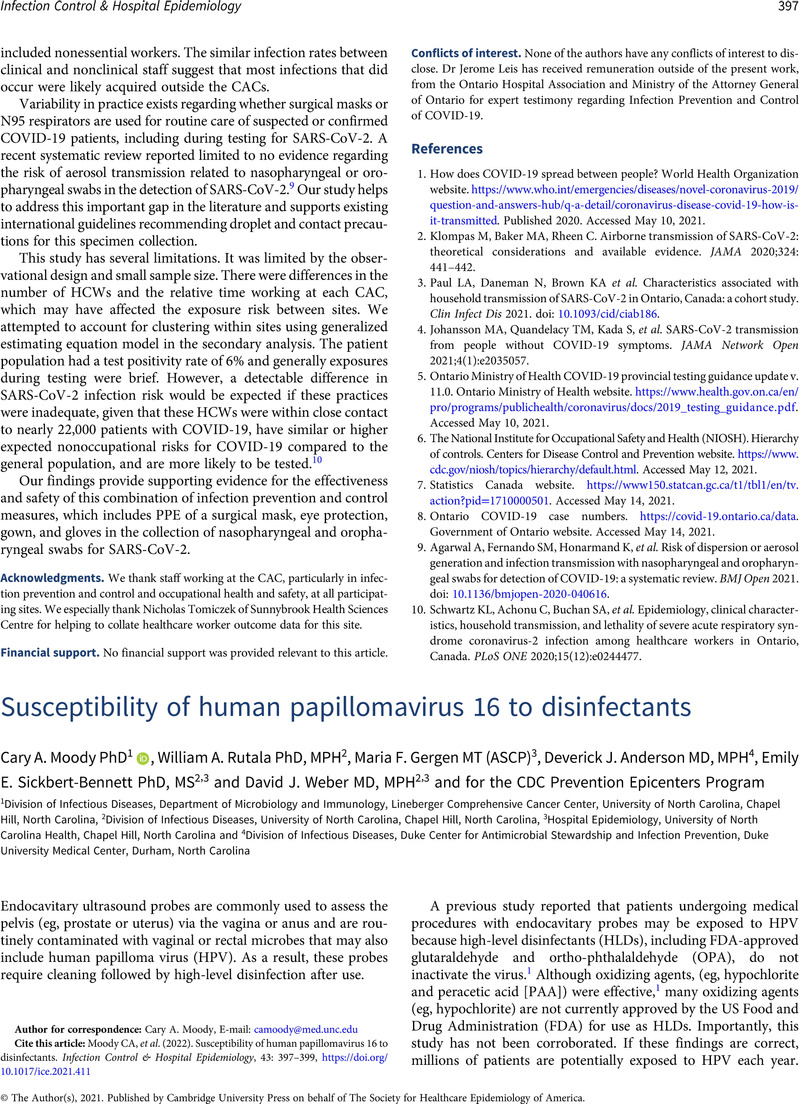No CrossRef data available.
Article contents
Susceptibility of human papillomavirus 16 to disinfectants
Published online by Cambridge University Press: 01 October 2021
Abstract
An abstract is not available for this content so a preview has been provided. Please use the Get access link above for information on how to access this content.

- Type
- Research Brief
- Information
- Copyright
- © The Author(s), 2021. Published by Cambridge University Press on behalf of The Society for Healthcare Epidemiology of America
References
Meyers, J, Ryndock, E, Conway, MJ, Meyers, C, Robison, R. Susceptibility of high-risk human papillomavirus type 16 to clinical disinfectants. J Antimicrob Chemother 2014,69;1546–1550.Google ScholarPubMed
Rutala, WA, Weber, DJ. Registration of disinfectants based on relative microbicidal activity. Infect Control Hosp Epidemiol 2004;25:333–341.Google ScholarPubMed
Ozbun, MA, Bondu, V, Patterson, NA, et al. Infectious titres of human papillomaviruses (HPVs) in patient lesions, methodological considerations in evaluating HPV infectivity and implications for the efficacy of high-level disinfectants. EBioMedicine 2021;63:103165.Google ScholarPubMed
Egawa, N, Shiraz, A, Crawford, R, et al. Dynamics of papillomavirus in vivo disease formation and susceptibility to high-level disinfection—implications for transmission in clinical settings. EBioMedicine 2021;63:103177.Google ScholarPubMed
Christensen, ND, Dillner, J, Eklund, C, et al. Surface conformational and linear epitopes on HPV-16 and HPV-18 L1 virus-like particles as defined by monoclonal antibodies. Virology 1996;223:174–184.Google ScholarPubMed
Ozbun, MA. Human papillomavirus type 31b infection of human keratinocytes and the onset of early transcription. J Virol 2002;76:11291–11300.Google ScholarPubMed
Culp, TD, Christensen, ND. Kinetics of in vitro adsorption and entry of papillomavirus virions. Virology 2004;319:152–161.Google ScholarPubMed
McDonnell, G, Russell, AD. Antiseptics and disinfectants: activity, action, and resistance. Clin Microbiol Rev 1999;12:147–179.Google ScholarPubMed
Rutala, WA, Weber, DJ, HICPAC. Guideline for disinfection and sterilization in healthcare facilities, 2008. Centers for Disease Control and Prevention website. https://www.cdc.gov/infectioncontrol/pdf/guidelines/disinfection-guidelines-H.pdf. Accessed September 21, 2021.Google Scholar
Fischer, M, Renevey, N, Thur, B, Hoffmann, D, Beer, M, Hoffmann, B. Efficacy assessment of nucleic acid decontamination reagents used in molecular diagnostic laboratories. PLoS One 2016;11:e0159274.Google ScholarPubMed



